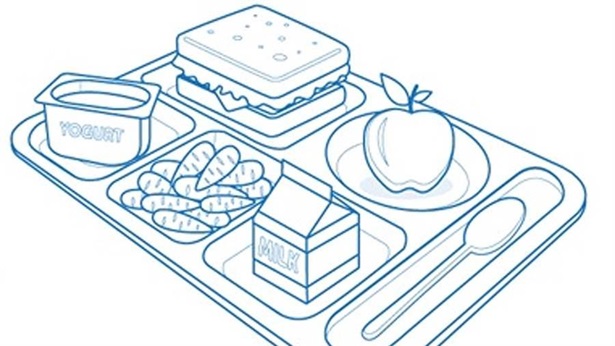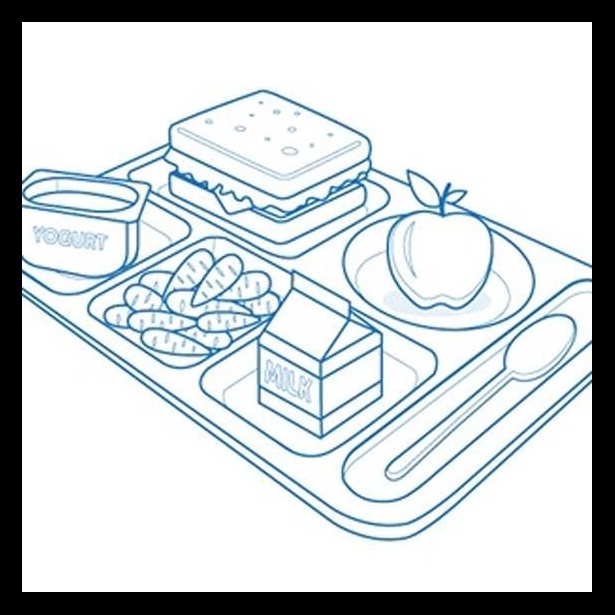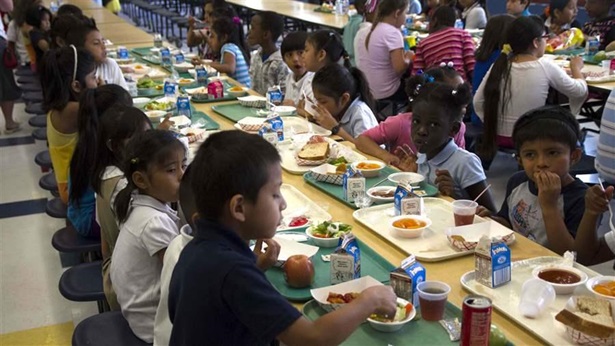Serving Healthy School Meals in California
The National School Lunch Program operates in nearly all public schools and 94 percent of public and private schools combined. The main goal of the school lunch and breakfast programs is to promote the health and well-being of children by ensuring that they have access to nutritious meals that support normal growth and development. Schools that participate in the programs must make nutritionally adequate meals available to all students and provide free or reduced-price meals to children from low-income families. During the 2012-13 school year, California schools used this program to serve more than 4.5 million meals each day, or more than 559 million lunches for the school year.
This report focuses on the major challenges in California school kitchens and cafeterias, and what is needed—improved equipment and infrastructure, and enhanced personnel training—to serve healthy, appealing meals.
OVERVIEW AND RECOMMENDATIONS
Overview
Schools play a crucial role in influencing children’s health, which in turn affects academic achievement. Adopting strategies that improve health, such as encouraging healthy eating throughout the school day, should be a priority for all schools. More than 3.2 million children in California participate in the National School Lunch Program each school day,1 and students can consume up to half of their daily calories at school.2 Unfortunately, many schools have not invested in the equipment and infrastructure of school kitchens and cafeterias, leaving them challenged in their efforts to serve healthy meals and meet children’s dietary needs.
The U.S. Department of Agriculture updated national school meal standards in 2012 to ensure that school meals promote children’s healthy development. These updates—the first in more than 15 years, based on current child nutrition science3—require schools to serve more fruits, vegetables, and whole grains while limiting saturated fat, sodium, and calories. Some states began updating nutrition standards even earlier; California, for example, began in the late 1990s.
To fully understand the school food service equipment, infrastructure, and training needs that exist today and how best to address them, The Pew Charitable Trusts and the Robert Wood Johnson Foundation, with support from The California Endowment, conducted the Kitchen Infrastructure and Training Study nationally and in California in the fall of 2012. The information presented in this report is based on that self-administered, online survey of California school food service directors or their designees (primarily food service managers) from a representative sample of the administrators of public school food authorities. The survey data give a clear picture of the kitchen upgrade and training needs statewide and within the northern, central, and southern regions.
The good news is that healthier meals are being served by the vast majority of school food authorities (SFAs) that administer the National School Lunch Program and the School Breakfast Program, despite the challenges they face. As of March 2014, USDA had certified 95 percent of California schools as meeting the updated standards.4
Even so, schools continue to face hurdles to successful implementation, such as inadequacies of their existing kitchen equipment and infrastructure and limitations in the knowledge and skills of food service staff.5
Some infrastructure challenges have resulted from funding fluctuations. For many years following the creation of the National School Lunch Program in 1946, the federal government offered funding for school kitchen equipment, but those programs ended. Many states and districts did not prioritize these needs, and the difficulties of working with outdated equipment and infrastructure grew.
Nearly 30 years later, in 2009 and 2010, USDA used funds primarily from the American Recovery and Reinvestment Act to provide $125 million to SFAs nationally—$12.8 million of which went to California—for the purchase, renovation, and replacement of food service equipment. These dollars made a tremendous difference, paying for improvements such as salad bars, expanded breakfast programs, and more “scratch” cooking—meals made from fresh ingredients instead of processed foods. In 2013, USDA allocated $11 million and then $25 million in 2014, with a total of $4.5 million going to California schools. Yet the funding, while welcome, could not address all of the impediments faced by school districts nationwide or in California.
Recommendations
In light of the report findings and a series of specific suggestions discussed in the Kitchen Infrastructure, Training, and Equipment in Schools Workshop, the project recommendations are as follows:
Recommendation 1: Federal, state, and local governments should prioritize funding to help schools upgrade kitchen equipment and infrastructure.
- Decades of reduced budgets and lack of supplemental funding sources have left 9 out of 10 schools
(93 percent) in California needing at least one piece of kitchen equipment to deliver quality meals to students. Policymakers should make school nutrition a high priority area when developing budgets.
Recommendation 2: Nonprofit and for-profit organizations interested in improving children’s health, education, school infrastructure, and community wellness should consider assisting schools in assessing the need for and feasibility of enhancing infrastructure and acquiring the necessary equipment.
- While needs vary from school to school, the five most needed pieces of equipment are utility carts, serving utensils, knives and cutting boards, and walk-in refrigerators and freezers. Focusing on these items or helping schools address a common concern such as refrigeration for fruits and vegetables could have a tremendous effect on the school nutrition environment.
Recommendation 3: Students’ nutritional needs should be considered in the master plans developed by district leadership that guide capital improvements. School officials and local policymakers should work collaboratively with school food service directors, parents, and community members to identify and implement strategies that meet equipment, infrastructure, and training needs.
- A range of strategies, such as leveraging partnerships, cultivating sponsors, obtaining low-interest loans, and generating revenue for services outside of the school meal setting, were identified and highlighted in “Serving Healthy School Meals: Financing Strategies for School Food Service.” These models, available at http://www.pewtrusts.org/kitchen-equipment, should serve as a guide to districts looking to tackle these challenges.
ENDNOTES
1 U.S. Department of Agriculture, Food and Nutrition Service, “National School Lunch Program: Total Participation, FY 2013 (Data as of
August 8, 2014),” accessed Aug. 14, 2014, http://www.fns.usda.gov/pd/01slfypart.htm.
2 Mary Story, “The Third School Nutrition Dietary Assessment Study: Findings and Policy Implications for Improving the Health of US Children,” Journal of the American Dietetic Association 109, no. 2 (2009): S7–S13, doi: 10.1016/j.jada.2008.11.005.
3 Institute of Medicine, School Meals: Building Blocks for Healthy Children (2009), http://www.iom.edu/reports/2009/school-meals-building-blocks-for-healthy-children.aspx.
4 U.S. Department of Agriculture, Food and Nutrition Service, “HHFKA Section 201 Administrative Funds Spending Progress and School Meals Compliance Rates: Percent of Districts Certified as of March 2014,” accessed Aug. 18, 2014, http://www.fns.usda.gov/sites/default/files/subcert.pdf.
5 The Pew Charitable Trusts, Kids’ Safe and Healthful Foods Project, Serving Healthy School Meals: Despite Challenges, Schools Meet USDA Meal Requirements (2013), http://www.pewtrusts.org/en/research-and-analysis/reports/2013/09/30/serving-healthy-school-meals.
6 Katherine Ralston et al., The National School Lunch Program: Background, Trends, and Issues, Economic Research Report 61, U.S. Department of Agriculture, Economic Research Service (2008), http://www.ers.usda.gov/publications/err-economic-research-report/err61.aspx#.U9vRWWNCq6I.
7 California Department of Education, “Food Programs,” accessed Feb. 10, 2014, http://www.cde.ca.gov/ds/sh/sn/#annual.
8 Field Research Corp., “Voter Concerns About Risk Factors for Obesity and Diabetes Have Eclipsed Other Health Concerns Facing
California Kids Over the Past 10 Years,” Release 2460 (2014), http://field.com/fieldpollonline/subscribers/Rls2460.pdf.
9 California Education Code 49590 (1997), accessed Aug. 1, 2014, http://www.leginfo.ca.gov/cgi-bin/displaycode?section=edc&group=49001-50000&file=49590.
10 California Department of Education, “Restrictions on Food and Beverage Sales” (2006), accessed May 5, 2014, http://www.cde.ca.gov/ls/nu/sn/mb06110.asp.
11 California Education Code 49431.7 (2007), accessed Aug. 1, 2014, http://www.leginfo.ca.gov/pub/07-08/bill/sen/sb_0451-0500/sb_490_bill_20070417_amended_sen_v97.html.
12 California Department of Education, “Restrictions on Food and Beverage Sales.”
13 “Nutrition Standards in the National School Lunch and School Breakfast Programs: Final Rule,” U.S. Department of Agriculture, 7 C.F.R Parts 210 and 220, Fed. Reg. 77 (17) (Jan. 26, 2012).
14 U.S. Department of Agriculture, Food and Nutrition Service, “HHFKA Section 201 Administrative Funds.”
15 California Legislative Analyst’s Office, “Maintaining Education Facilities in California: The 2014-15 Budget” (2014), accessed Aug. 1, 2014, http://www.lao.ca.gov/reports/2014/budget/education-facilities/maintaining-facilities-041114.pdf.
16 The Pew Charitable Trusts, Kids’ Safe and Healthful Foods Project, Serving Healthy School Meals.
17 Ibid.
18 Ibid.












